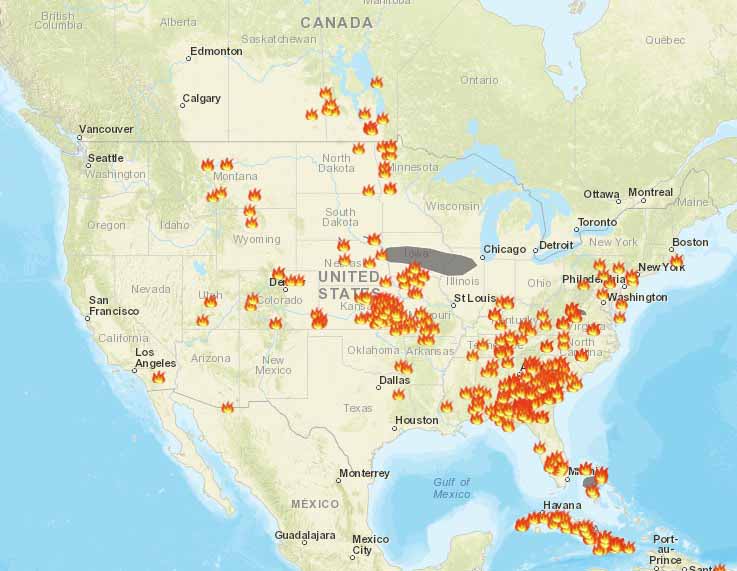Above: A view of the wildfires in Kansas, Oklahoma, and Texas as seen from a NASA satellite on March 7, 2017. The red areas represent heat.
In some areas of the United States crossing over a state line can bring a person into a completely different wildfire suppression structure. I first noticed the difference between Oklahoma and Kansas while attempting to gather current information about the fires that broke out in both states during very windy Red Flag Warning conditions that began on March 6, 2017. Many fires broke out in both states but the largest became an interstate emergency when several fires burned together straddling the Kansas/Oklahoma border blackening over 700,000 acres.
The larger firefighting organization in Oklahoma, the Oklahoma Forestry Services (OFS), was able to provide much more information to the public about the ongoing situation than the smaller agency in Kansas, the Kansas Forest Service (KSF).
A recent article by Oliver Morrison of the Tribune News Service pointed out one of the differences between the two agencies:
Oklahoma had to learn the hard way that Kansas fights fires unlike almost anywhere else in the U.S., according to George Geissler, the director of the Oklahoma Forest Service.
Instead of reaching out to a single Kansas agency during the Anderson Creek fire last year — which burned nearly 400,000 acres near Medicine Lodge — Oklahoma had to reach out separately to each Kansas county impacted by the fire. Each county gave the fire a different name, Geissler said, and often provided “wildly different” reports about how much damage the fire had done.
So before this year’s fire season kicked off, Geissler took several of his 80 full-time staff members to meet with all five fire people at the Kansas Forest Service responsible for coordinating the state’s response to wildfires. They shared information about how each state handles wildfires.
Below is an excerpt from an article in the Wichita Eagle:
The state’s forest service is the smallest and lowest funded of any in the country – which puts people and property in danger.
Consider the difference in resources and responses between Kansas and Oklahoma:
–The Kansas Forest Service budget in 2016 was about $3 million, with $1 million dedicated to fire service; Oklahoma’s budget was $15 million, with $8 million for fire service.
–The Kansas Forest Service has three trucks and four employees dedicated to firefighting and fire prevention; Oklahoma has 47 fire engines, 47 bulldozers and 84 firefighters.
–On March 6, when the wildfire started, Oklahoma had a plane in the air by 3 p.m. to help firefighters. It was two more days before Kansas could get a rented plane to help in Clark County, after most of the county had burned.
Mr. Morrison reported that “Oklahoma’s total state firefighting budget is about $15 million”.
Kansas budgeted $3,250,985 for the KFS in 2016. Of that total, only 10 percent, or $328,673, came from the state’s general fund, while another $248,384 was generated by technical assistance fees and tree sales. The rest was provided by the federal government (47 percent, or $1,538,660) and state and federal grants (35 percent, or $1,143,268).
In recent years Kansas Governor Sam Brownback, backed by the legislature, has cut taxes in the state.
The New York Times reported on February 22:
Yet Kansas has struggled in the aftermath of the tax reductions, and the state has been rattled by debates about paying for public education and social services. This month, S&P Global Ratings issued a “negative” outlook for its credit rating for Kansas, where the economic growth that Mr. Brownback thought the tax cuts would produce has not materialized. Last summer, S&P downgraded Kansas’ credit rating, to AA-.
It is very likely that the KFS will see even smaller budgets in coming years if the new administration in Washington implements their expressed desire to impose large spending cuts in the federal budget. The President’s proposal is to cut the U.S. Forest Service’s “Payments to State Funds” by 75 percent. The 82 percent provided to the KFS by the feds and grants could be much smaller in the coming years.
But Oklahoma has its own budget worries, with a 10.6 percent cut in funding to the OFS’ umbrella agency, the Department of Agriculture, Food and Forestry after a $1.3 billion state budget shortfall due largely to low energy prices. One of the immediate effects is the closure of four OFS offices.
Kansas has been one of a handful of states that have not become members of interstate wildland fire compacts that provide the means for its member states and provinces to cope with fires that might be beyond the capabilities of a single member. But after two years in a row that saw huge fires burning in the state the legislature passed a bill last week that allows them to become a member of a compact. The one they join could be the Great Plains Interstate Fire Compact comprised of six states and one Canadian province.
In Mr. Morrison’s article he pointed out an issue related to ordering resources for an ongoing fire in Kansas:
During the massive wildfires on March 6, the emergency managers at the state level were using a different system than the emergency managers at the county level, which was a different system than the state Forest Service was using, according to Ross Hauck, who attended the meeting for the Forest Service.
“So the guys in the state emergency operations center were sometimes ordering the same people,” Hauck said.




